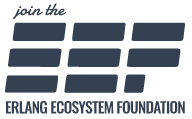Elixir is a dynamic, functional language for building scalable and maintainable applications.
Elixir runs on the Erlang VM, known for creating low-latency, distributed, and fault-tolerant systems. These capabilities and Elixir tooling allow developers to be productive in several domains, such as web development, embedded software, machine learning, data pipelines, and multimedia processing, across a wide range of industries.
Here is a peek:
iex> "Elixir" |> String.graphemes() |> Enum.frequencies()
%{"E" => 1, "i" => 2, "l" => 1, "r" => 1, "x" => 1}Check our Getting Started guide and our Learning page to begin your journey with Elixir. Or keep scrolling for an overview of the platform, language, and tools.
Companies using Elixir in production
See more cases →Platform features
Scalability
All Elixir code runs inside lightweight threads of execution (called processes) that are isolated and exchange information via messages:
current_process = self()
# Spawn an Elixir process (not an operating system one!)
spawn_link(fn ->
send(current_process, {:msg, "hello world"})
end)
# Block until the message is received
receive do
{:msg, contents} -> IO.puts(contents)
endDue to their lightweight nature, you can run hundreds of thousands of processes concurrently in the same machine, using all machine resources efficiently (vertical scaling). Processes may also communicate with other processes running on different machines to coordinate work across multiple nodes (horizontal scaling).
Together with projects such as Numerical Elixir, Elixir scales across cores, clusters, and GPUs.
Fault-tolerance
The unavoidable truth about software in production is that things will go wrong. Even more when we take network, file systems, and other third-party resources into account.
To react to failures, Elixir supervisors describe how to restart parts of your system when things go awry, going back to a known initial state that is guaranteed to work:
children = [
TCP.Pool,
{TCP.Acceptor, port: 4040}
]
Supervisor.start_link(children, strategy: :one_for_one)The combination of fault-tolerance and message passing makes Elixir an excellent choice for event-driven systems and robust architectures. Frameworks, such as Nerves, build on this foundation to enable productive development of reliable embedded/IoT systems.
Language features
Functional programming
Functional programming promotes a coding style that helps developers write code that is short, concise, and maintainable. For example, pattern matching allows us to elegantly match and assert specific conditions for some code to execute:
def drive(%User{age: age}) when age >= 16 do
# Code that drives a car
end
drive(User.get("John Doe"))
#=> Fails if the user is under 16Elixir relies on those features to ensure your software is working under the expected constraints. And when it is not, don't worry, supervisors have your back!
Extensibility and DSLs
Elixir has been designed to be extensible, allowing developers to naturally extend the language to particular domains, in order to increase their productivity.
As an example, let's write a simple test case using Elixir's test framework called ExUnit:
defmodule MathTest do
use ExUnit.Case, async: true
test "can add two numbers" do
assert 1 + 1 == 2
end
endThe async: true option allows tests to run in parallel, using as many CPU cores as possible, while the assert functionality can introspect your code, providing great reports in case of failures.
Other examples include using Elixir to write SQL queries, compiling a subset of Elixir to the GPU, and more.
Tooling features
A growing ecosystem
Elixir ships with a great set of tools to ease development. Mix is a build tool that allows you to easily create projects, manage tasks, run tests and more:
$ mix new my_app
$ cd my_app
$ mix test
.
Finished in 0.04 seconds (0.04s on load, 0.00s on tests)
1 test, 0 failures
Mix also integrates with the Hex package manager for dependency management and hosting documentation for the whole ecosystem.
Interactive development
Tools like IEx (Elixir's interactive shell) leverage the language and platform to provide auto-complete, debugging tools, code reloading, as well as nicely formatted documentation:
$ iex
Interactive Elixir - press Ctrl+C to exit (type h() ENTER for help)
iex> h String.trim # Prints the documentation
iex> i "Hello, World" # Prints information about a data type
iex> break! String.trim/1 # Sets a breakpoint
iex> recompile # Recompiles the current projectCode notebooks like Livebook allow you to interact with Elixir directly from your browser, including support for plotting, flowcharts, data tables, machine learning, and much more!
Erlang compatible
Elixir runs on the Erlang VM giving developers complete access to Erlang's ecosystem, used by companies like WhatsApp, Klarna, and many more to build distributed, fault-tolerant applications. An Elixir programmer can invoke any Erlang function with no runtime cost:
iex> :crypto.hash(:sha256, "Using crypto from Erlang OTP")
<<192, 223, 75, 115, ...>>To learn more about Elixir, check our Getting Started guide.

